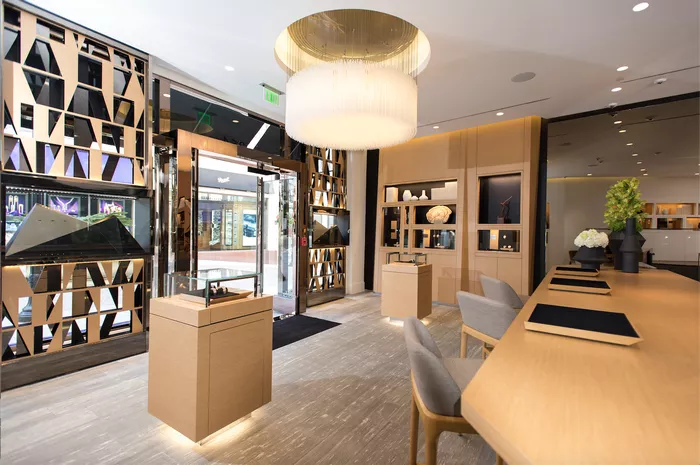In 2017, when Georges Kern took the helm as the chief executive of Breitling, the Swiss watchmaker had a mere seven boutiques scattered across North America, concentrated mainly in the predictable urban hubs like New York City, Miami, and Toronto.
Fast forward to the present, and the brand is on track to reach a remarkable milestone by year-end, with a projected total of 43 boutiques across the continent. This rapid expansion, including fresh additions in unexpected locations like New Orleans, Salt Lake City, and Laval, a Montreal suburb, underscores the seismic shift happening in the world of luxury timepieces.
Breitling’s spree of store openings, however, isn’t confined to North America alone. By the close of 2024, their ambitious goal is to have a staggering 350 boutiques worldwide, dwarfing the mere 56 in existence back in 2017. Recent arrivals in far-flung destinations like Hanoi, Vietnam; Hyderabad, India; and Sapporo, Japan, demonstrate Breitling’s determination to meet customers where they are.
Georges Kern, speaking from one of Breitling’s newest stores in Manhattan’s meatpacking district, emphasized the catalyst behind this expansion: the transformation of consumption habits during the Covid-19 pandemic. People discovered the convenience of shopping in their hometowns, whether through online purchases or in-store visits with services like curbside pickup. Asking customers to travel to big cities for a watch purchase became increasingly outdated, prompting the brand to pivot towards local engagement.
Georges Kern is not alone in his vision. Many other chief executives in the Swiss watch industry have pivoted away from the digital-first approach that seemed imminent in 2020. In a surprising turn, they have redoubled their commitment to enhancing the in-store experience.
Consider, for instance, the flurry of new watch boutiques that have materialized since May. Jacob & Co., now boasting the world’s largest watch boutique on Olaya Street in Riyadh, Saudi Arabia, stands as a testament to this shift. Panerai, with its 2,174-square-foot flagship on Madison Avenue, New York City, and the renovated Bucherer 1888 TimeDome on the Las Vegas Strip, is elevating the in-store experience to new heights.
Adding a twist to this narrative, Rolex recently dropped a bombshell by announcing its acquisition plan for the Swiss retailer Bucherer, a partnership that has endured since 1924. The move demonstrates Rolex’s dedication to a wider array of offerings.
The future promises even more expansion. Citizen, for instance, is gearing up to unveil a three-level, 7,000-square-foot flagship near Rockefeller Center in Manhattan in December, aiming to provide customers with an immersive watch-buying experience.
David Hurley, deputy chief executive of the Watches of Switzerland Group, underscores the fierce competition for prime retail locations, driven in part by luxury giants like LVMH, who have significantly invested in commercial real estate. The race to expand existing stores from 5,000 to 15,000 square feet is emblematic of this trend. Watches of Switzerland, too, is embarking on an ambitious expansion plan, with a third city location slated for January 2024, cementing their presence in the heart of New York City.
Luxury watch demand surged during the pandemic, with enthusiasts making purchases from the comfort of their homes. Yet, this surge aligns with a broader trend that dates back over a decade, originating in the aftermath of the 2008 financial crisis. Many brands decided to shift from wholesale distribution to opening monobrand boutiques, allowing them greater control over their image and supply chain.
Today, brands are clustering in promising locations like the Mall at Short Hills in Millburn, N.J., creating a shopping haven for watch aficionados. The growing concentration of luxury boutiques offers customers an unparalleled shopping experience.
Ira Melnitsky, president of Bucherer USA, notes the immense untapped potential in the U.S. market, accounting for a significant portion of Swiss watch exports. Similar growth prospects are evident in Europe, Asia, and the Middle East, where brands like Chopard, Hublot, and Zenith have recently opened boutiques to cater to the burgeoning demand for luxury timepieces.
Even independent watchmakers, with their modest production volumes, are focusing on establishing physical stores. H. Moser & Cie, based in Schaffhausen, Switzerland, has expanded its footprint with flagship stores in Hong Kong and Shanghai. In addition to this, they are experimenting with lounge concepts designed to prioritize hospitality over transactions, fostering a unique brand experience. Similar trends are emerging among smaller players, such as Massena LAB, which plans to open Massena House, a club-like space, in New York City.
For larger brands like Ulysse Nardin, the focus remains on enhancing the in-store experience and storytelling, recognizing that customers crave a deeper connection with the brand and its heritage. This shift towards a more personal and immersive experience is redefining the brick-and-mortar landscape, demonstrating that in the digital age, physical stores can thrive when they prioritize engagement and community-building.
In a world where luxury brands compete fiercely for prime retail real estate, the race is on to offer customers something beyond just products. The watch industry’s embrace of brick-and-mortar stores represents a compelling evolution in the luxury shopping experience, where exclusivity, storytelling, and community engagement are the new currency.


